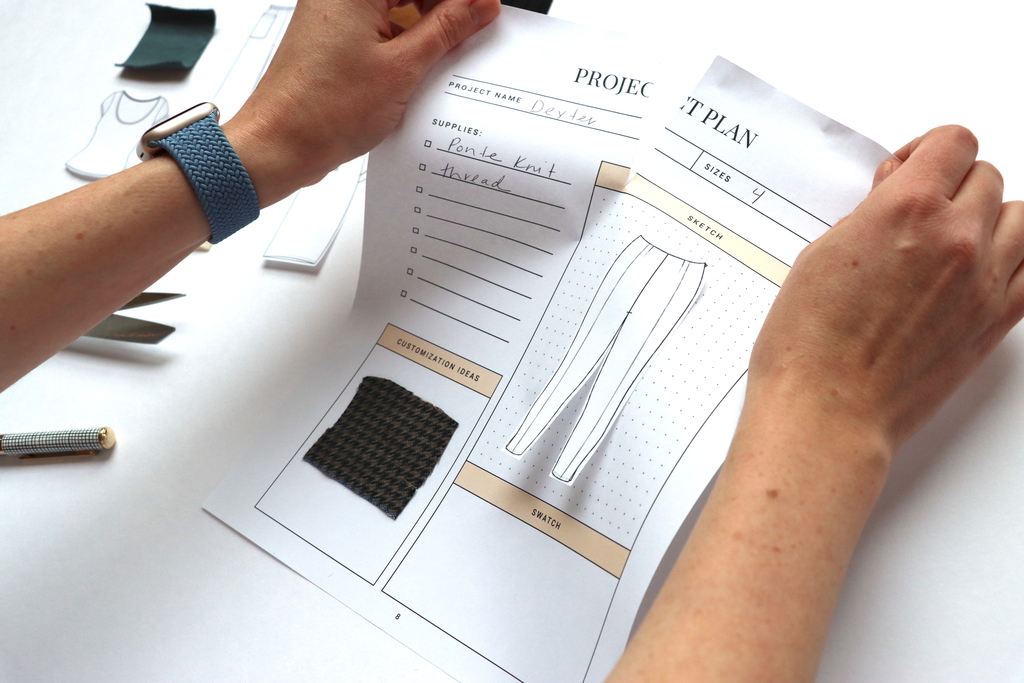Keep reading for the entire podcast transcript, formatted so it's easy to scan. You'll find a bulleted recap of all the tips at the bottom of the article!
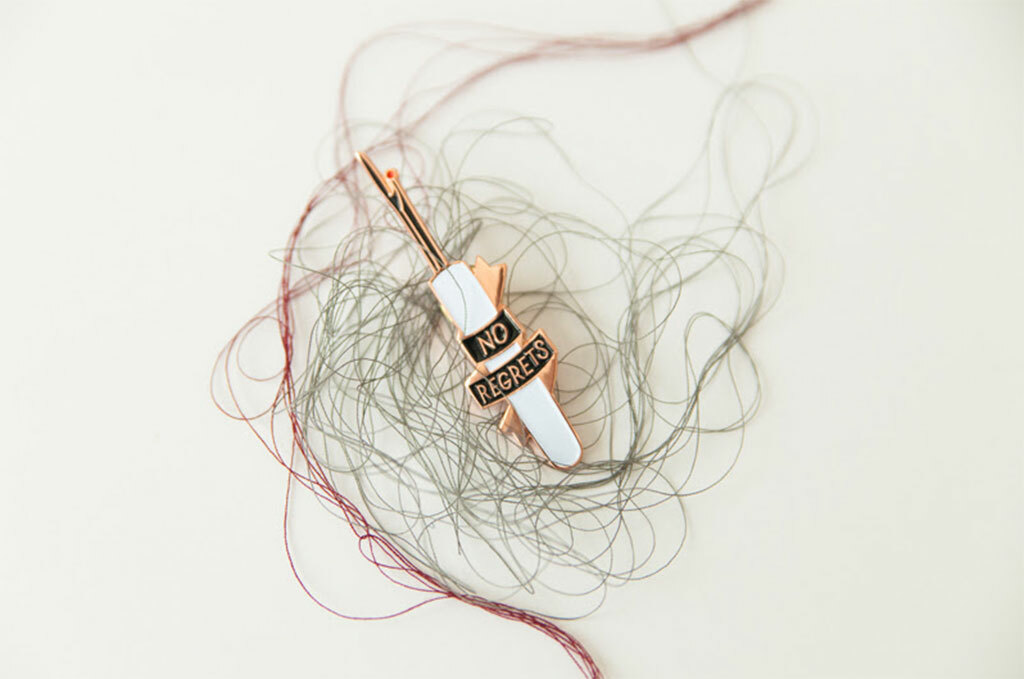
Podcast Transcript
Sarai
I'm Sarai.
Haley
And I'm Haley.
Sarai
And this is Seamwork Radio. Welcome back to Seamwork Radio, where we share practical ideas for building a creative process so you can sew with intention and joy.
Today we're talking about three steps to letting go of mistakes. And we're going to cover what to do when you start to feel really frustrated when you're sewing and how you can recover quickly so you can get back to having fun.

Icebreaker: Do you talk out loud to yourself when you sew?
Sarai
All right, let's start with our icebreaker for today. So, today's icebreaker, I'm just going to read it the way it's written, and it was written by Sally G. So thank you, Sally, for contributing this question today. So Sally says, “So my icebreaker is something my friends and husbands have mentioned.” She says husbands—I don't know if she's talking about multiple husbands. “My friends and husbands have mentioned a lot. I talk to myself during sewing, as in I make a dialogue, like being my own teacher. Well, I'm not always aware that I'm doing this, but I do like talking out loud during my sewing. For example, I might say, ‘okay, so now I'm going to cut out my fabric’, or ‘should I check the instructions once again before I commit?’ I find it helps to crystallize my thought processes. Does anyone else talk out loud to themselves in this way?”
Thank you for that question, Sally. I was thinking about this. I think I talk to myself when I sew, but probably not more than I do when I'm doing other things. What do you think? Do you talk to yourself a lot when you sew?
Haley
I agree. Probably no more than I normally do. And I tend to do this when I'm kind of moving on to the next step, like, okay, I interfaced everything. Okay, cool, let's stay stitched it all. So I do that.
This makes me think of something. When I first started teaching sewing, there was another teacher that I knew, and she helped mentor me and kind of teach me tricks of running a classroom and stuff. And she told me to get in the habit of vocalizing things that maybe you take for granted, because you've been doing them for so long, and they're just very natural to you. Get in the habit of narrating everything that you're doing.
And I started doing that when I was sewing at home, even when I was cooking or doing my makeup. It just made me get in the habit of explaining things that I was doing. And I honestly was one of the best pieces of advice that I got when I first started out my teaching career.
Sarai
That's really interesting.
Haley
So maybe, Sally, you should consider a career in teaching sewing.
Sarai
Yeah, you'd probably be a great teacher, Sally. I will say, I think maybe when I'm reading things and trying to process what I'm reading, like in the instructions, I might read them out loud. Sometimes that helps just to hear them spoken out loud. I think I talk more to the cats than I do to myself, though they're usually in here, causing a lot of problems. So talking might not be the term I would use. Lecturing, maybe.
Well, thank you so much for the question, Sally. It's a good one and I think it's a good segue into what we're talking about today. Thanks a lot for leaving that one.
And if you want to share an icebreaker with us that we could use on a future episode, you can share it with us by going to seamwork.com/go/icebreakers. And if you're a Seamwork member, that's going to take you right to the thread on the community for the podcast where you can add your icebreaker that we will be checking so we can use it on a future episode. So thank you again, Sally.
So talking about mistakes and how to get over them today—this is actually something I've been thinking about a lot, which is the inner voices in our head.
I think a lot of times for a lot of us, we have this inner critic that comes out when we're doing anything hard, really. And I think that's a very typical experience, and a lot of times we kind of identify with that voice. So we consider that voice in our head to be us, right, when really there are all these different voices in our head, and they might all have different messages for you.
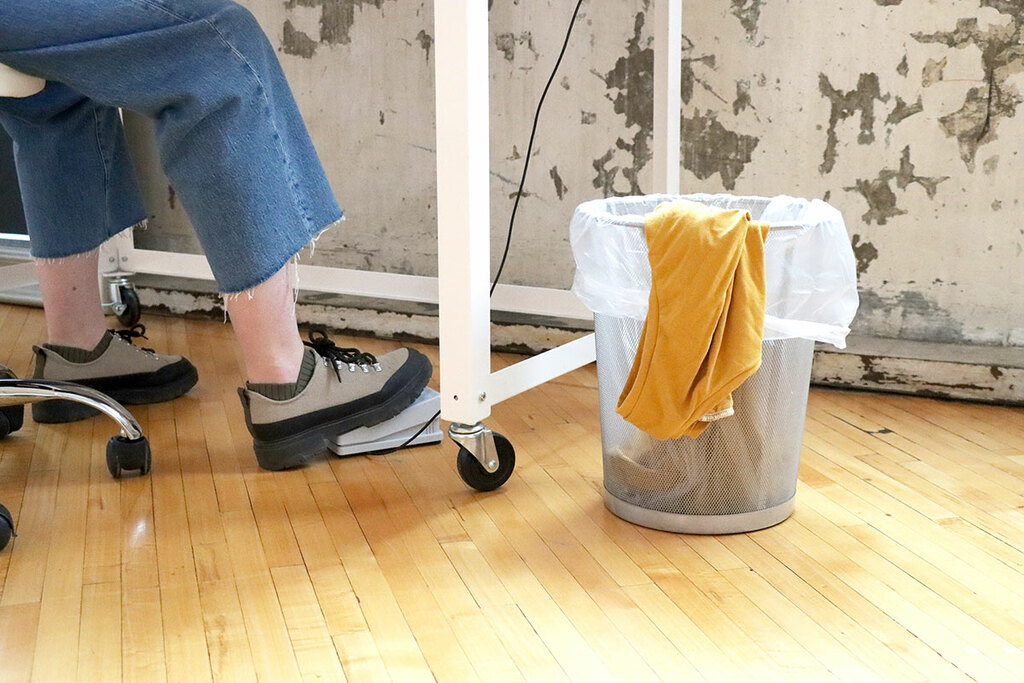
Sometimes when you're doing something hard, you tend to listen to that inner critic's voice the most. So we want to talk about ways that you can kind of get away from that, because sewing and learning how to sew is really a prime area for mistakes.
Mistakes are going to happen, you're going to make mistakes. Because of that, you really need to build the muscle that's going to help us learn to cope with those mistakes. And that means getting to know that inner critic and really making friends with her or him.
Some people experience the inner critic. I was reading about this recently, actually, because I wrote an issue on it for my personal newsletter about inner voices, and that some people actually don't have an inner monologue at all.
Like they don't have words in their head.
I have a cousin who is actually that way—the thoughts do not appear in her head as words or a voice or anything like that, which is really interesting. And that's how it is for some people. Then for other people, it might be more visual, and for other people, they actually experience sort of a character or multiple characters in their heads.
It's really interesting because—there’s a lot of diversity in how most people experience more of a voice that they identify with—but there's a lot of diversity in how people experience it, which I think is really, really interesting.
I was reading about this and thinking, because this is something that I have worked on a lot, and I tend to believe that we actually have all these voices in our head. And the inner critic voice is not necessarily a bad voice, but it is something that you have to kind of get friendly with over time.
So we're going to talk about some steps to reframe those moments when you start feeling frustrated and you start hearing that voice, that inner critic voice, and it's not making you feel good.
And if you have that experience with sewing, because I think all of us do from time to time, you could try going through them the next time you hit a roadblock and see if they help.
So to start us off, I just want to talk about mistakes a little bit in general. So, Haley, maybe you could tell us what was your most recent sewing mistake?
What was your last sewing mistake?
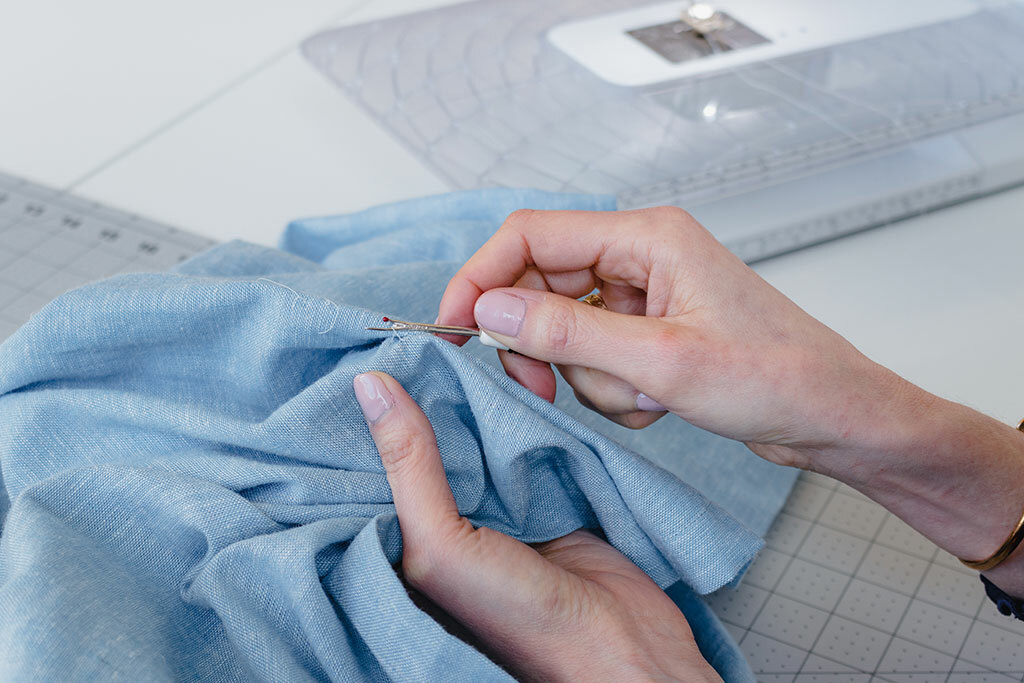
Haley
I make so many sewing mistakes all the time. I know, we were filming a video the other day or yesterday for YouTube, and I was working on our BERNINA that we use for video. And that's not my sewing machine. I only use it really when we're filming, which is kind of high-pressure, this kind of semi-foreign machine that I only use when I'm being recorded.
Sarai
Yeah. And it's kind of fancy. It has a lot of features.
Haley
It has a lot of features. And I'm very confident in different kinds of sewing machines, which is why I made a mistake, because I was like, I know how this buttonhole feature works. And I started treating it like I did on another machine that I assumed it was very similar to, and it was not. And I was like, “Why is this messed up? Why do I keep making weird buttonholes?” Well, if I would have stopped and maybe like, I don't know, read the manual, I would have discovered very quickly what I was doing wrong. But yeah, I was just like, "Man, this machine, this machine is messed up. What's going on?” Which actually is funny because that's not the place I go immediately when I make mistakes. Typically, I'm like, oh, no, what am I doing? I'm so stupid. I'm making so many mistakes. But I was just so blissfully ignorant in this situation, which is kind of funny.
Sarai
It's funny that you were doing a video on buttonholes, too, that you're struggling so much.
Haley
Yeah. A little behind the scenes.
Sarai
Yeah. It's hard when your machine doesn't participate with you, because I feel like that's the most frustrating. I get so frustrated with technology of any kind when it doesn't do what I want it to do.
Haley
Yeah. It just is different from my buttonhole feature. And there's a few different ways that a buttonhole can work on a machine. And I was kind of assuming that it was one type, and I should never assume. This is how I used to sell sewing machines, is by showing people left their fancy buttonholes. I sold a sewing machine to Giovanni Ribisi once, because I showed him the very fancy automatic buttonhole that this machine had. He was buying it for his daughter.
Sarai
That's cool.
Haley
Yeah. Related to buttonholes, but yeah. What about you? What was your most recent sewing mistake?
Sarai
Actually, the thing that came to mind wasn't a sewing mistake, it was a knitting mistake. I can veer from sewing mistakes, because I think it's very similar. I'm working on this sweater that I've been wearing on for a really long time, and I'm kind of towards the end, and I was working on the sleeves, and I had put the sweater down for a little while. I hadn't knitted on it for a week or two. So I picked it up again, and it had been kind of stuffed—I keep it inside this tote bag and it was stuffed inside of—and I opened it up. It's knit the round, if you're familiar with knitting. And I started knitting on it. I knitted like ten rows. I had gone quite a ways and I looked at it. It doesn't look right. Why does this look weird? And then I realized that I had accidentally turned the sweater inside out before I had started knitting on it again. So I was knitting the wrong side on the outside.
Haley
So you were purling.
Sarai
Yeah, it was like a special rib pattern. So it had a right side and a wrong side to it. And I had to rip back everything, like probably an hour's worth of knitting, which is not that big a deal in knitting. That happens all the time. But it was definitely frustrating, especially because I really wanted to finish the sweater soon.
I don't know, it was a mistake that was, I guess, a little bit carelessness, but also just the kind of thing that happens. It just happens and you might not notice it at first and then you do. And I think that's one of the things with knitting is that you learn that mistakes are going to happen and that it might take a really long time to fix it. But it's just kind of part of the process. Even more so than with sewing, I think, because everything takes so long with knitting. That was annoying, though.
Haley
Annoying, but highly relatable. Is there a mistake that you've repeated frequently or do you think that you tend to learn from your mistakes quickly?
Do you repeat mistakes, or do you learn from them?
Sarai
Mostly I would say that I tend to learn from my mistakes. I'm trying to think if there's anything that I repeat frequently. I would say the only one might be cutting the corner of making a muslin sometimes, because sometimes you need one sometimes you don't need one, and you have to kind of make that determination. I'm making that determination right now with a pair of pants that I want to make—the Chelsea Jeans, but because they're a stretch fabric, I'm kind of wondering, do I make a muslin? Because the fabric has to have the same properties, otherwise it's not going to tell me the true fit. So I'm trying to figure that out, and I feel like that's an area where I tend to falter sometimes and make the same mistake over and over again, but it's not so much because I'm not learning, but it's a hard determination to make sometimes.
Haley
Yeah, that's so true.
Sarai
What about you?
Haley
Well, first I want to say that with the Chelsea Jeans, you should just make the muslin, because even if it's not exactly the same stretch, I think you'll still be able to learn enough, and it'll tell you things about the rise and the Y axis.
Sarai
I was thinking about making a wearable muslin.
Haley
I’m team, when in doubt, make one, especially for pants.
Sarai
I feel like pants makes sense.
Haley
It's almost sacrilege not to make a muslin, to be totally honest. Like, you're making something maybe like elastic waist or something, and then even then, I'll do a little tissue fit on it.
Let's see. I would say that I tend to learn from my mistakes pretty quickly. I have a really good memory, and my inner critic has an even better memory than I do, so she refuses to let me forget anything. I think that really the only mistakes that I make frequently are, like, little technical mistakes, things that I just always hate doing. Bartacks. I always hate sewing bartacks because I feel like they always turn out, like, a little bit different. Doesn't matter if you test it. They just always turn out, at least on my machine, just a little different every time.
So that's a mistake I make, and I probably should, like, dedicate some time next time to really just sit down and spend an hour with some bar tacks and figure it out. But I'm always like, I hate this step. Let's just get it over with.
What is your first reaction when you make a mistake?
What’s your first reaction when you make a mistake?
Sarai
Oh, yelling and cursing, definitely.
Haley
Me too. Maybe an F-bomb, if I'm being completely honest.
Sarai
Yeah, you always have that reaction at first, I think at least I do. I get angry at first. I mean, it's frustrating, you're spending all this time making something, and then it might not even ruin it. It might just take, like, five minutes to fix, but it's frustrating every time.
Haley
Well, it breaks your flow. And I find that even if it's an easily fixable mistake, I'm so inconvenienced by the fact that I was just, like, vibing with my project, and then this mistake pops up, and I'm like, dang it, now I got to deal with this.
Sarai
Yeah, that's definitely my first reaction. I don't get super angry. I'm not, like, throwing things across the room. Usually. I can’t say I haven't thrown anything across the room.
Tips for letting go of mistakes
Well, let's get into the tips, because I think there is a process that you can follow. And it's not like a hard and fast process, but it's something that you can keep in your mind for when you do hit these roadblocks. And it might help you out just to kind of process it and get through it and move past it.
Acknowledge whatever you’re feeling (and then move on)
So the first thing so we've got three steps today, and the first step is to just start with how you're feeling. So you can be mad or sad or disappointed, but then move on. So don't dwell on your mistakes. And I think this is easier said than done. I don't know. For some reason, it feels good to, especially if it's anger, that comes up for you. it kind of feels good to get angry about something.
The first step is really, I think, key, and the first part of that is just acknowledging that you're upset. And I was just telling you, Haley, before we started recording that, I was reading this article by a therapist that was talking about labeling your feelings and just using words that like, a six-year-old would use to label your feelings, because adults tend to try to over-intellectualize what they're feeling and say, “Oh, I'm disappointed, or I'm frustrated,” instead of just saying “I'm mad or I'm sad,” which I thought was really interesting and kind of a cool approach to thinking about how you're talking to yourself about your feelings.
And we've talked about several times on the podcast, that kind of inner child, and just listening to that voice can be really good.
So acknowledge that you're upset, acknowledge that you're mad or that you're sad, however you're feeling at that moment, and then it's time to move through it. So maybe set a timer to help you kind of, like, give yourself a limit on how long you're just going to sit around feeling angry or sad about it. You could put it in kind of a time-out pile or a naughty pile if you want to, if you need to, to kind of help you just kind of give yourself that time away from it.
Haley
Yeah, a little space.
Sarai
Yeah, sometimes that's all you need. Sometimes you need some physical space away from it.
I know when I get really frustrated with something I'm doing, whether it's a sewing project or a knitting project or whatever, I just need to put it away for a while and come back to it. So I'm not feeling quite so emotional.
You could take a break and eat. You can hydrate, stretch, whatever you need to do to start making yourself physically feel better. That can be a really helpful thing to do. And then by the time you're back at your machine, you'll just be more calm and able to concentrate.
So really the key here is letting yourself have whatever bad feelings you're having, but then giving yourself the space to move beyond those bad feelings, you know, taking a break and really letting yourself just relax for a little while.
Haley
Yeah. I think the key is that if you try to move forward and problem-solve when you're in this upset state of mind, the solutions aren't going to come as easily to you, and the chances that you're going to make an additional mistake are so much higher.
Sarai
So much higher. I can't tell you how many times that's happened to me. Just trying to, especially if it's late at night, or you're tired, or you're hungry.
Haley
Yeah. And you have, like, a self-imposed deadline. You're like, I really thought I was going to finish this tonight, and now I have to finish this tonight.
Sarai
Yeah, I get that way sometimes because I've made such a mess in my sewing room, and I don't want to have to clean it all up just to make another mess again the next day or whenever I'm going to get back to it. I just want to finish so that I can put everything away.
And I don't know, that's pretty silly, like, to force yourself into a state of stress because you don't want to clean up more than once. But we all go through those things. I think we all kind of have those weird little quirks that cause us to put more stress on ourselves than we need to.
So that was the first step. The second step is to recognize the creative potential within the mistake.
Recognize the creative potential in your mistake
So this is about really problem solving and making it work.
Once you've taken that break, you've stepped away from it for a while, now it's time to come back to it, and you can kind of turn it into your own little Project Runway challenge. So just imagine that Tim Gunn is at your desk, he's at your sewing table, and he's telling you—what does he say?
It's make it work time, right?
Haley
“Make it work, designers.”
Sarai
So sometimes that's what you have to do. And depending on what the problem is, the creative solution could be different. So it could just be a matter of seam ripping. You might just need to rip back whatever problem that you have, but it also might be an opportunity to go back to the drawing board.
- Maybe a dress can become a skirt or a top (here’s a pattern hack for that).
- Maybe you can color-block something (here’s a tutorial).
- Maybe you can add an embellishment or change things up a little bit (here are 25 ideas to do that).
There's a lot of different creative ways to solve a mistake other than just straight up fixing it.
So I think it's interesting to start with that mindset of—is this a creative challenge? And not just, this is a problem.
That's the second step. And then the third step is to find what the lesson is and then how you're going to apply it next time. I think that's key—figuring out how you're actually going to use it.
Find the lesson and then apply it
Sarai
If the fit was bad, for example, maybe like me, you should have made a muslin for this. I'm glad we're doing this little, like, pre-mortem on my sewing project, because now I'm not going to make this mistake.
Did the fabric misbehave? Maybe if that was the problem. Maybe the lesson you learned is that you should sew in some test swatches or try a fabric stabilizer or some other method that's going to help make the fabric easier to work with.
Did you have a problem with the construction? Maybe the next time you need to read the instructions before you start to sew, maybe that's the lesson that you took away from it.
Did you try a new technique? Maybe you need to do a practice run first, if that was the case.
Or maybe you just didn't have the right tool for the job. Whatever it is, there's always a lesson that you can learn from any mistake that you've made. And so identifying what that lesson is and then figuring out how you're going to actually make use of that lesson the next time you sew something or the next time you sow something similar will really help to kind of cement it in your mind, so that what you take away from the experience is not just frustration or not just a failed project if you can't recover it, but something that you can actually use to help you grow in your sewing practice and learn some new skills.
So those are the three steps for getting past your mistakes. Pretty simple.
Recap: 3 tips for letting go of mistakes
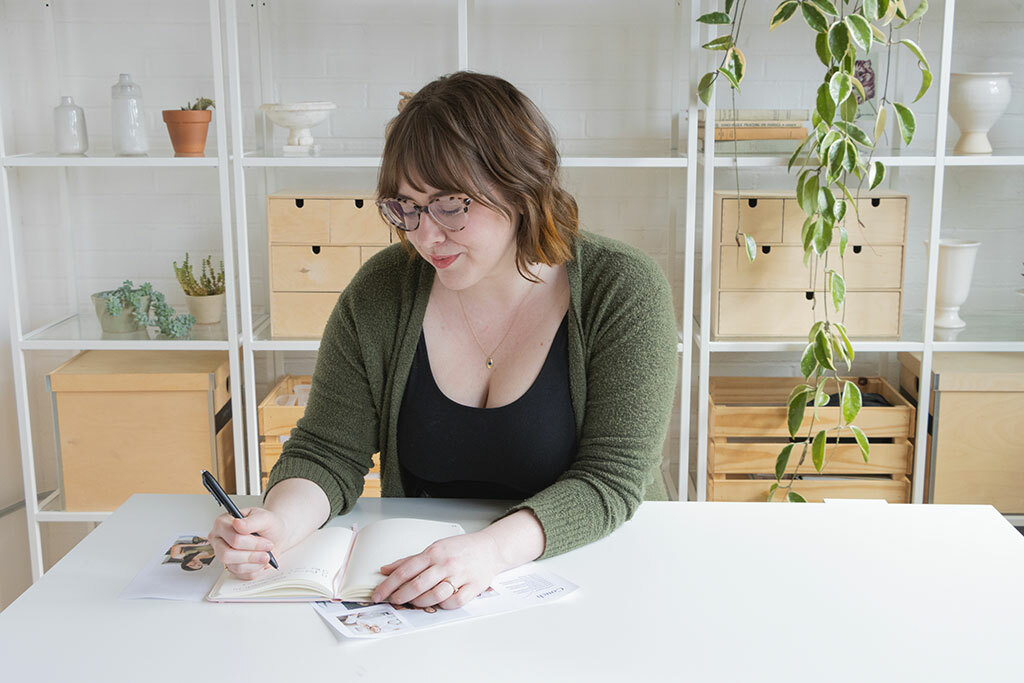
Haley
Yeah. So just to recap, the three steps are:
-
Feel your feelings. Allow yourself to sit with those feelings, maybe take a break, put the project in time-out, and then come back to it when you're feeling in a better state of mind over the whole fiasco. -
The next step is to recognize the creative potential in the mistake. It's time to put on your problem-solving cap. Maybe it's as simple as seam ripping. Maybe it's an opportunity to add an extra detail or get creative with it. -
And then step three is to find the lesson and apply it for next time, so that you're just continuously learning and finding a silver lining in your worst mistakes. Because, trust me, we all have them.
Sarai, what’s your big takeaway from this?
Sarai
I think mine is obvious. I need to make a muslin for those Chelsea jeans. I think it's really helpful to think about what are the mistakes that do come up for you over and over again. And like I said, that's one for me. So that you can kind of figure out where that's coming from. Like, for me, maybe it's that I'm in a rush or I'm so excited about the project, I want to have the finished thing done and I don't want it to take a couple of weeks for me to do it.
So if that's the kind of thing that keeps leading to mistakes, sort of looking at the why behind it can be really helpful. And for me, rushing in my life is probably the number one cause of stress generally. So that's a good lesson. It's a sewing lesson and life lesson for me.
What about you?
Haley
That's a really good one. I think I might have to piggyback off of that. Really when I reflect on it, the root of a lot of my sewing snafus is not taking my time with things, and that shows up in kind of various different ways. It can be me assuming I know how to do something when I do not. It can be me not wanting to slow down and make a nice bartack because I don't want to.
Sarai
That does sound like your inner child. I don't want to.
Haley
I don't want to. The bartacks I make are by no means like, horrible. I just know they could be better.
Sarai
I’m sure you're the only one who notices.
Haley
Yeah, no, that's totally the case. And so maybe that's another takeaway. Is is my inner critic even right? Maybe not.
Sarai
Yeah, maybe not. I find she's right about 5% of the time.
Haley
Okay.
Sarai
It's just exaggeration.
Haley
I will tally and report back.
Well, if you are looking to you're stuck on a project, you maybe need to practice a new technique and you want a little bit of guidance. I think that you should definitely go check out our YouTube channel.
On YouTube. We have a new free sewing video every single week and we have a huge library of over 200 videos. We've been making videos on YouTube for quite a while now, so there's a lot of really great gems you can find there. So if you're stuck on something, maybe go check it out and we might have a video to help you. You can find us at YouTube.com/c/seamworkvideo or search seamworkvideo on YouTube and you will see Sarai's face and my face there. And I think that you would love it if you subscribed.
Sarai
Yeah, you'll definitely like it. If you like the podcast, you will enjoy our YouTube channel. We're doing a lot of cool stuff on there right now. We're doing a lot of project diaries and also a lot of tutorials. It's been a lot of fun.
Haley
Yeah, you could go watch a project diary and watch Sarai mess up in real time.
Sarai
Yeah, I'm going to film one next week, and I'm sure I will mess something up.
Haley
Yeah. The good, the bad and the ugly.
Sarai
I can't promise you'll see me curse or throw anything because I might save that for off camera, but…
Haley
I want a refund.
Well, if you liked this episode, we would just love if you left us a review. It helps other people to find our podcast so that more people who love sewing just like we do can find us and listen to us. You can leave us a review. You can leave us some stars. You can tell a friend about us. We would just appreciate and love any of the above. Today we have a review from Tete Danmar, and they write, “Love the content and the way it is presented. Always learn something, and I enjoy the lovely hosts and their respectful dialogue with each other.”
Sarai
I love that we're respectful.
Haley
I like that, too. I like to think so, but I'm glad that comes across.
Sarai
I wonder if this person listens to a lot of disrespectful podcasts.
Haley
Yeah.
Sarai
Where people are just dissing each other.
Haley
That would be a really interesting spin-off episode where we just roast each other. So stay tuned for that.
Sarai
No, that is a really nice compliment, though.
Haley
Yes. Thank you so much for leaving that, and I really mean it when I say it, that they just means so much to us, and we love reading them, so keep them coming.
Sarai
All right, well, that does it for us this week. Thank you for joining us. I'm Sarai.
Haley
And I'm Haley.
Sarai
And this is Seamwork Radio.
